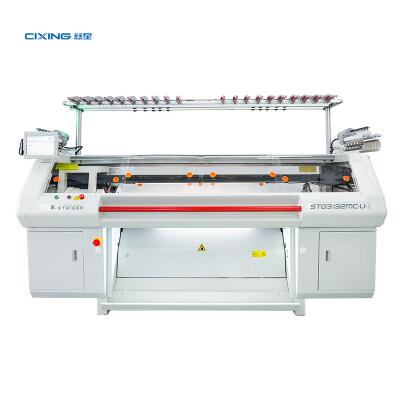Key Components of a Flat Knitting Machine: Understanding the Mechanism
2024-09-10
Flat knitting machines are essential in the textile industry for producing flat fabrics such as sweaters, scarves, and other garments. These machines offer a more versatile method of knitting, enabling the creation of intricate patterns and structures. In this blog, we will explore the key components of a flat knitting machine and explain how they work together to produce high-quality knitted fabrics.

1. Needle Bed
The needle bed is one of the most critical components of a flat knitting machine. It holds and supports the needles, which are responsible for creating the stitches. Unlike circular knitting machines, flat knitting machines have two flat needle beds facing each other. These beds move back and forth, allowing the machine to create fabric rows horizontally. The number of needles on the bed determines the width of the fabric and the gauge, or fineness, of the knit.
2. Knitting Needles
Knitting needles in flat knitting machines play the primary role in the formation of loops or stitches. There are various types of needles, but the most commonly used in flat knitting are latch needles. These needles have a small latch that opens and closes as the yarn is looped through, forming the stitch. The needles move up and down through slots in the needle bed during operation.
3. Carriage
The carriage is a mobile part of the machine that moves across the needle bed. Its main function is to guide the needles in making stitches by controlling their vertical movement and feeding yarn into the knitting zone. The carriage moves back and forth along the length of the bed, interacting with the needles to knit, purl, or create more complex patterns like cables or lace. The speed and movement of the carriage are controlled either manually or by computerized programming.
4. Yarn Feeder
The yarn feeder supplies yarn to the needles, ensuring a consistent flow for fabric creation. It directs the yarn from the spool to the knitting area. Flat knitting machines often have multiple yarn feeders, especially in advanced models, allowing for multicolor knitting or the use of different types of yarns in the same fabric.
5. Take-Down System
After the needles create the stitches, the fabric needs to be pulled downward to maintain tension and facilitate continuous knitting. The take-down system performs this function by applying controlled tension on the fabric as it is knitted. This ensures that the fabric is uniformly drawn down and that the stitches remain consistent in size and tension.
6. Sinker
Sinkers are small, thin metal plates that work alongside the needles to hold the fabric down during knitting. As the needles rise to form new loops, the sinkers hold the previously formed stitches in place. This ensures that the stitches do not move or stretch, contributing to the overall consistency of the knitted fabric. Sinkers are especially important in creating ribbed or purl patterns.
7. Cam System
The cam system controls the movement of the needles, determining whether they rise or fall during knitting. Each cam is designed with a specific path that influences the needle's movement. As the carriage moves across the needle bed, the cams interact with the needles, enabling different knitting techniques like knit, purl, or holding loops. In modern computerized machines, the cam system is often replaced or enhanced by digital controls.
8. Control Panel (Computerized System)
In modern flat knitting machines, the control panel is a computerized system that automates the knitting process. Operators can input patterns, adjust knitting speed, tension, and other variables using the control panel. This system enhances precision, allowing for the production of complex designs and reducing manual labor. The control panel also monitors machine performance and can detect errors such as yarn breaks or misfeeds.
9. Tensioning Device
Yarn tension is critical to maintaining the consistency of stitches in the fabric. The tensioning device ensures that the yarn is supplied to the needles at the correct tension, preventing it from being too tight or too loose. Proper tension control helps in producing uniform fabric, avoiding variations in texture or size.
Conclusion
Flat knitting machines rely on the seamless interaction of these components to produce high-quality knitted fabrics. From the needles and needle bed to the carriage, yarn feeder, and cam system, each part plays a vital role in the overall performance of the machine. With the advancements in technology, especially the integration of computerized controls, flat knitting machines have become highly efficient and capable of producing complex and detailed fabric patterns.
Understanding these key components is essential for machine operators and designers alike, as it enables better control over the knitting process, ensuring consistent, high-quality output.


